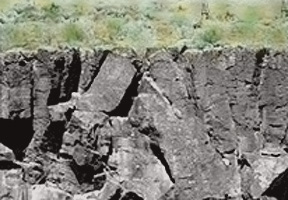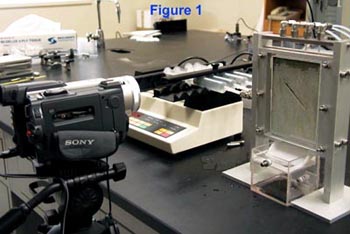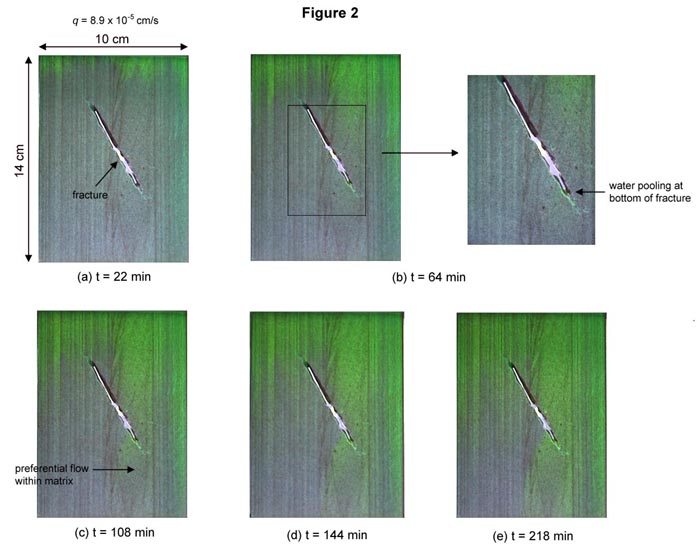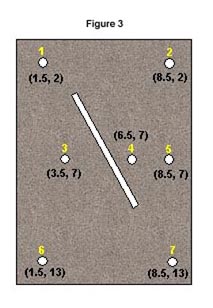


Fractures in the unsaturated zone play an important role in water infiltration and contaminant transport. Field and laboratory experiments have demonstrated that flow can occur preferentially along fractures in the unsaturated zone, leading to travel times much faster than predicted by conventional conceptual models that are based on Richards' equation.
Laboratory experiments are essential to obtain a fundamental understanding of flow in unsaturated fractures and to identify mechanisms that may not be described using the conventional models. The objectives of our laboratory studies are to

A photograph of the apparatus used to conduct visualization experiments on rectangular slabs of Berea sandstone (10 x 15 x 0.6 cm) with a permeability of 10-13 m2 is shown in Figure 1. A slit was cut through the center of the sample to create a fracture approximately 2 mm wide, about 6 cm long, and oriented at an angle in the range of 60 degrees from the horizontal. The sample was saturated with water before delivering water to it at a constant flux by means of a syringe pump.Fluxes less than the saturated hydraulic conductivity of the sample (9.8 x 10-5 cm/s) were applied so that unsaturated conditions were established in the rock matrix. After approximately 24 hours, fluorescein dye was added to the inlet water and blacklight was used to aid in visualizing the water movement through the sample. A digital camera recorded the water movement. A photograph of the apparatus used to conduct these experiments is shown in Figure 1.
Figure 2 contains images of the dyed water (shown in green) moving through a slab of Berea sandstone for an input flux of 8.9 x 10-5 cm/s. The isolated fracture in this sample is oriented 60 degrees from the horizontal. The time indicates minutes after dyed water was introduced into the sample. Flow becomes localized through the rock matrix because of the presence of the isolated fracture, occurring preferentially along the top of the fracture and to the right side of the sample. Pooling of water at the terminus of the fracture was also observed in this experiment, suggesting the development of free-surface film flow along the isolated fracture walls. At a lower input flux of 7.1 x 10-5 cm/s, water did not accumulate at the end of the fracture, suggesting a flux threshold occurs between 7.1 x 10-5 and 8.9 x 10-5 cm/s for the formation of the free-surface films for the sample with a fracture oriented at 60 degrees.


Matrix pressure measurements were made in the Berea sandstone sample with a fracture inclination of 60 degrees. Holes were drilled through seven points in the sample. The locations of the seven pressure ports in the rock matrix are shown on the sketch in Figure 3. The values in the parentheses in Figure 3 are the x,y coordinates of the ports given in centimeters. Filter paper with a pore size of 0.7mm was placed inside the holes. The filter paper was saturated and connected to a pressure transducer by water-filled tubing, creating a tensiometer. The backside of the hole was sealed with a small piece of wax. Table 1 (below) presents the average values of the pressures measured at the seven ports for input fluxes of 4.4 x 10–5 cm/s and 7.1 x 10-5 cm/s. At 4.4 x 10–5 cm/s the pressure in port 1 is less than port 2, but at 7.1 x 10-5 cm/s, the pressures in ports 1 and 2 are nearly the same. The pressure in port 3 is considerably less than the pressures in ports 4 and 5 at 4.4 x 10–5 cm/s. At 7.1 x 10-5 cm/s, the pressures in ports 4 and 5 are slightly larger than the pressure in port 3. At the bottom of the sample, the pressure in port 6 is also less than the pressure in port 7 for both flow rates. Since the saturation increases with increasing matrix pressure, these results indicate that the saturation in the matrix is higher on the right side of the sample, which corresponds to the location where the faster flow path was observed in the visualization experiment
| Port Number | Pressure (cm of H2O) for q=4.4x10-5cm/s | Pressure (cm of H2O) for q=7.1x10-5cm/s |
| 1 | -2.8 | -1.1 |
| 2 | -1.4 | -1.0 |
| 3 | -4.3 | -1.4 |
| 4 | -1.5 | -0.8 |
| 5 | -1.4 | -1.1 |
| 6 | -4.1 | -2.6 |
| 7 | -1.7 | -1.0 |
Measurements of water saturations in the Berea sandstone samples are currently underway using the computerized tomography scanner in the Petroleum Engineering Department at Stanford University. Actual fractured rock samples from the Navajo Sandstone site in Utah may also be used in laboratory experiments through collaboration with Vic Heilweil of the Utah District.
| National Research Program | USGS | Water Resources | UZ Flow Homepage |